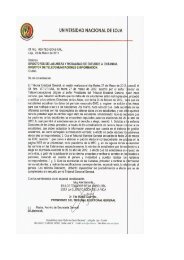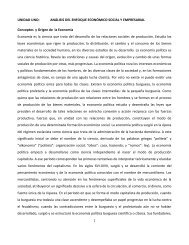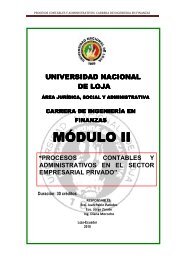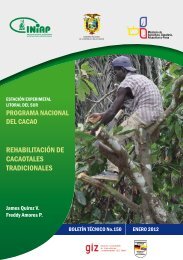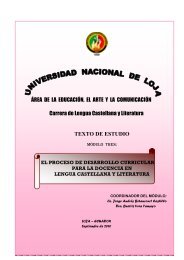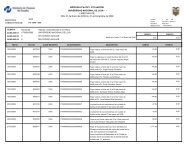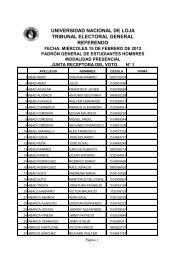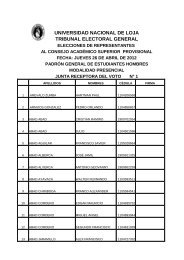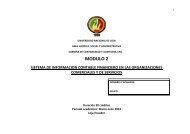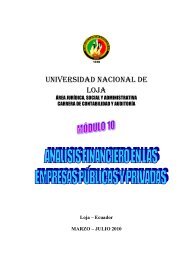module 5 planning of the english language teaching-learning process
module 5 planning of the english language teaching-learning process
module 5 planning of the english language teaching-learning process
Create successful ePaper yourself
Turn your PDF publications into a flip-book with our unique Google optimized e-Paper software.
UNIVERSIDAD NACIONAL DE LOJA<br />
Área de la Educación el Arte y la Comunicación<br />
English Language Career<br />
In <strong>the</strong> Presentation, Practice and Production (PPP) lesson<br />
− The lesson has a <strong>language</strong> aim.<br />
− The teacher first contextualises <strong>the</strong> new <strong>language</strong>, i.e. puts it into a<br />
situation which shows what it means. (Step 1).<br />
− The teacher <strong>the</strong>n makes sure that <strong>the</strong> students remember previously studied<br />
<strong>language</strong> needed to practice <strong>the</strong> new <strong>language</strong> by eliciting it, i.e. asking<br />
students to say <strong>the</strong> <strong>language</strong> ra<strong>the</strong>r than giving it to <strong>the</strong>m, and by doing a<br />
choral drill (getting <strong>the</strong> students to repeat as a whole class what he/she<br />
says). (Steps 2-3)<br />
− The teacher next presents <strong>the</strong> new <strong>language</strong> and <strong>the</strong> students just listen.<br />
(Step 4)<br />
− The students <strong>the</strong>n say sentences including <strong>the</strong> new <strong>language</strong> in a very<br />
controlled or restricted practice activity, i.e. one in which <strong>the</strong>y can use<br />
only <strong>the</strong> new <strong>language</strong> and without making mistakes. (Step 5)<br />
− The teacher tells students about <strong>the</strong> grammatical use <strong>of</strong> <strong>the</strong> new <strong>language</strong>.<br />
(Step 6)<br />
− The teacher asks <strong>the</strong> students concept questions, i.e. questions that check<br />
<strong>the</strong>ir understanding <strong>of</strong> <strong>the</strong> use or meaning <strong>of</strong> <strong>the</strong> new <strong>language</strong>. (Step 7)<br />
− The students <strong>the</strong>n carry out ano<strong>the</strong>r controlled practice activity. (Step 8)<br />
− The students do less controlled or freer practice (i.e. where <strong>the</strong>y can use<br />
<strong>the</strong>ir own ideas) using <strong>the</strong> new <strong>language</strong>. (Step 9)<br />
You can see that in a PPP lesson <strong>the</strong> teacher:<br />
1. presents new <strong>language</strong> in a context<br />
2. gets students to practice it in controlled practice activities<br />
3. asks <strong>the</strong> students to use <strong>the</strong> new <strong>language</strong> in less controlled activities, in a<br />
communicative way.<br />
In <strong>the</strong> Task-based Learning (TBL) lesson:<br />
The aim <strong>of</strong> <strong>the</strong> lesson is for <strong>the</strong> students to complete a task (an activity in<br />
which students try to achieve something real, and have to communicate to<br />
do so).<br />
The teacher starts by holding a discussion on <strong>the</strong> topic <strong>of</strong> <strong>the</strong> lesson. (Step<br />
1)<br />
The teacher <strong>the</strong>n gives <strong>the</strong> students tasks to do. (Steps 2, 3, 4, 5)<br />
Then <strong>the</strong> teacher and students discuss any new or problematic <strong>language</strong><br />
<strong>the</strong>y needed for <strong>the</strong> task. (Step 6)<br />
Lastly, <strong>the</strong> students do an exercise on <strong>the</strong> new <strong>language</strong>. (Step 7)<br />
You can see that in a TBL lesson <strong>the</strong> teacher:<br />
1. gives students tasks to do<br />
[Escribir texto] Página 62



